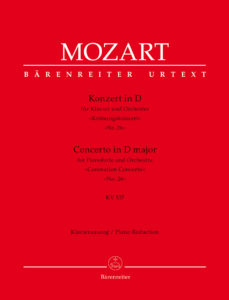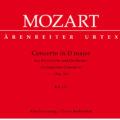One of the key aspects of a musiciant’s work is the availability of quality standard and editions as updated as possible: these are two of the essential elements of Bärenreiter editions, whose latest publications include a new reduction of Wolfgang Amadeus Mozart’s Piano concerto no. 26 in D major “Coronation” KV 537.
 Talking about Piano sonata in A major KV 331, we have already pointed out a concrete problem about sources and a real completeness of several Mozart’s compositions in every particular. To maintain the abovementioned exemple, a passage in the intriduction to the edition is symbolic saying that today we don’t have «one single ultimate musical text», but that KV 331 «is thus located between of the autograph and the first edition»: it’s the task of the scholar or of the performer «to compare them and draw their own conclusions».
Talking about Piano sonata in A major KV 331, we have already pointed out a concrete problem about sources and a real completeness of several Mozart’s compositions in every particular. To maintain the abovementioned exemple, a passage in the intriduction to the edition is symbolic saying that today we don’t have «one single ultimate musical text», but that KV 331 «is thus located between of the autograph and the first edition»: it’s the task of the scholar or of the performer «to compare them and draw their own conclusions».
Similar remarks can be made for Piano concerto KV 537, one of the most mysterious texts of the entire Mozart’s corpus, that may be considered a special happening: a fundamental problem of this particular piano concerto is the fact that «the left hand of the piano part was left unwritten for large stretches at a time, namely, where it presumably functioned as and accompaniment». The matter becomes severe when we learn that the left hand of the piano part was variously realised by editors that published the work, starting with the first edition André in 1794 (the only one that possesses a certain authority regarding the addition inserted by the editor Johann André that in all likelihood mey have heard personally the première of Piano concerto KV 537 in Frankfurt).
As you would expect, this is a too much extended and complex problem for us to discuss here, so all you need to know is that Bärenreiter edition is based on the music text from Neue Mozart Ausgabe (vol. V/15/8) and, regarding the additions extraneous to Mozart’s manuscript, these are identified by small print to dintinguish them from the rest of the readings deduced from the main sources, namely the autograph manuscript and the first edition.
 This new Bärenretier’s work, at a first glance too, presents its strong vocation to the practice, with its two volums – the first one with the solo piano part and the second one with both solo and orchestra’s reduction parts – and a booklet with a brief selection of cadenzas (inter alia the monumental cadenzas for the first two movements by Carl Reinecke).
This new Bärenretier’s work, at a first glance too, presents its strong vocation to the practice, with its two volums – the first one with the solo piano part and the second one with both solo and orchestra’s reduction parts – and a booklet with a brief selection of cadenzas (inter alia the monumental cadenzas for the first two movements by Carl Reinecke).
Certainly, the most interesting aspect is, however, the new piano reduction of the orchestral part by Martin Schelhaas. Extremely accurate and refined, this reduction moves greatly away from the previous one: less notes, more comfortable passages for the performer, the piano doesn’t try to mimic the orchestra but pursues a more fascinating aim, that’s the element that makes this edition a funtamental support for players, namely the research of the typical colour and spirit of Mozart’s music. The writing simplicity exactly fits to the refinment of Mozart’s score, exalts his melodic invention, the peculiar harmonic chainings, making the score attractive for a two pianos performance too.
This piano concerto, so unique for the circumstances that gave it birth and for the moltitude of “blank spaces” in the autograph, it’s a work that asks to be studied, performed, reinvented in each performance, and this new piano reduction allows to the players to find their way, delivering them the best means currently at our disposal, accurately chosen by Bärenreiter to place near as much as possible the modern-day performer to the authentic Mozart’s spirit.
lfmusica@yahoo.com
- Pisa celebra il “suo” Guglielmo Tell - 4 Marzo 2020
- “Don Giovanni” al Teatro Verdi di Pisa, un succès de scandale - 27 Gennaio 2020
- “Ernani” ritorna al Verdi di Pisa in cappa e spada - 17 Dicembre 2019



